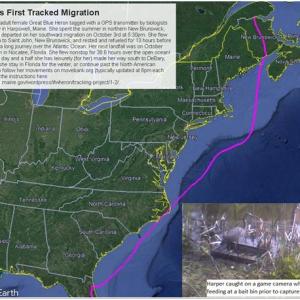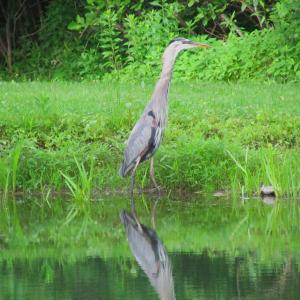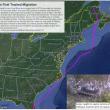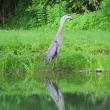Harper the Heron Makes 38-hour Nonstop Flight
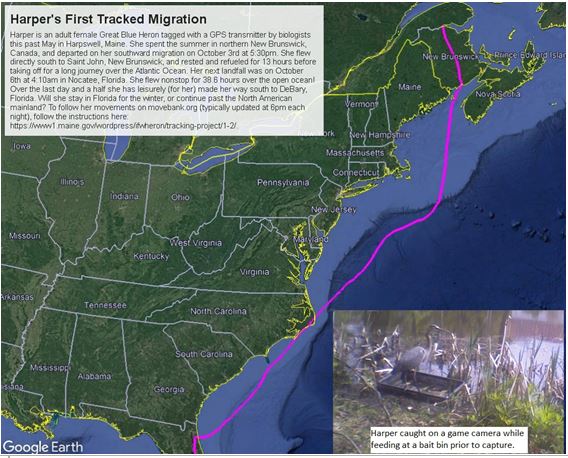 The 1,400-mile nonstop flight of Harper the Great Blue Heron. Courtesy Maine Department of Inland Fisheries and Wildlife
The 1,400-mile nonstop flight of Harper the Great Blue Heron. Courtesy Maine Department of Inland Fisheries and Wildlife
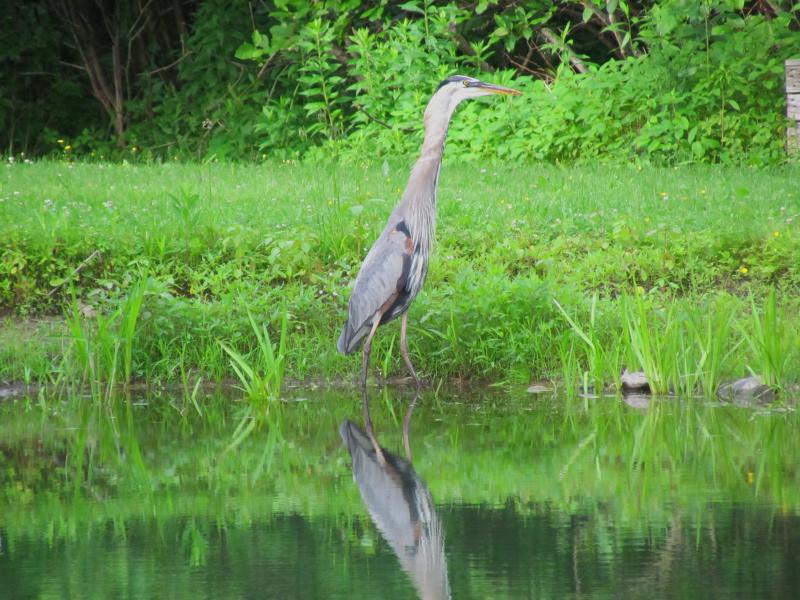 Changes in great blue heron numbers and distribution in the state led to the Maine Department of Inland Fisheries and Wildlife wanting to learn more about the species’ biology. Courtesy of Jeff Wells
Changes in great blue heron numbers and distribution in the state led to the Maine Department of Inland Fisheries and Wildlife wanting to learn more about the species’ biology. Courtesy of Jeff Wells
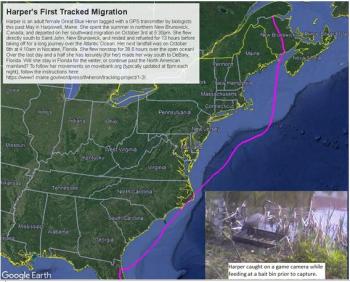 The 1,400-mile nonstop flight of Harper the Great Blue Heron. Courtesy Maine Department of Inland Fisheries and Wildlife
The 1,400-mile nonstop flight of Harper the Great Blue Heron. Courtesy Maine Department of Inland Fisheries and Wildlife
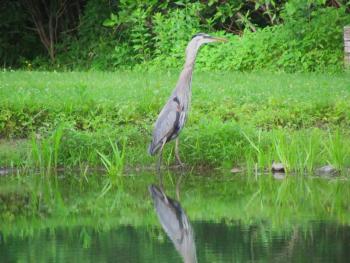 Changes in great blue heron numbers and distribution in the state led to the Maine Department of Inland Fisheries and Wildlife wanting to learn more about the species’ biology. Courtesy of Jeff Wells
Changes in great blue heron numbers and distribution in the state led to the Maine Department of Inland Fisheries and Wildlife wanting to learn more about the species’ biology. Courtesy of Jeff Wells
Great blue herons are one of the better known of Maine birds even if not always by that name. Many’s the time we have also heard them referred to as “cranes,” “egrets,” and the even occasionally as “sh-tpokes.” We won’t get into the origins for those other names but whatever you call them, they are large, tall birds, and people notice them.
In recent years, the number of nesting great blue herons along the coast has declined. Large island nest colonies have disappeared or have only a few nesting pairs. This decline has been attributed, at least in part, to an increase in the number of bald eagles. Bald eagles eat nestling great blue herons. After a great blue heron nesting colony has been hit a few times by one or more bald eagles using it as a lunch counter, eventually the adult herons decide it’s time to try nesting somewhere else the next nesting season. The herons also to have caught on that they are less likely to be detected and attacked by eagles if they are not nesting all together in large colonies.
Changes in heron numbers and distribution in the state were a factor that led to the Maine Department of Inland Fisheries and Wildlife wanting to learn more about the species’ biology. One of the most fascinating studies that they have been involved in is a migration tracking project. Working with students from different parts of the state, biologists have captured and placed tracking devices on a number of herons over the last few years. Maine great blue herons tracked in the project have spent winters in Florida and Haiti.
At least one of the birds stopped or passed over Southport in its migrations, based on maps that show the migration routes of the herons tagged. These are available on the web.
But this year a great blue heron named “Harper” by the Harpswell-area students who helped capture and tag her in Harpswell, wowed us all. The bird was captured in May when it was assumed that any great blue heron in the area would have been nesting nearby. Harper’s first surprise was that she took off and traveled from Harpswell all the way to northern New Brunswick where she spent the summer.
Apparently, some of the herons we may see here in Maine in May are still migrating north!
Harper’s second surprise was even more astounding. Late in the day on October third, she took off from Saint. John, New Brunswick, and headed south over the ocean. She never stopped flying for the next 38 and half hours, finally landing in the early morning hours of Oct. 6 in northern Florida. Harper had flown a mind-boggling 1,400 miles nonstop.
Over the next week or so, Harper made her way down through Florida, out over the Bahamas, and finally to Cuba where the researchers suspect she may stay for the winter. What an amazing journey for a bird from right here in Maine!
You can read more about the heron research and tracking project and find out how to get involved here.
Jeffrey V. Wells, Ph.D., is a Fellow of the Cornell Lab of Ornithology. Dr. Wells is one of the nation's leading bird experts and conservation biologists and author of “Birder’s Conservation Handbook”. His grandfather, the late John Chase, was a columnist for the Boothbay Register for many years. Allison Childs Wells, formerly of the Cornell Lab of Ornithology, is a senior director at the Natural Resources Council of Maine, a nonprofit membership organization working statewide to protect the nature of Maine. Both are widely published natural history writers and are the authors of the book, “Maine’s Favorite Birds” and “Birds of Aruba, Bonaire, and Curaçao: A Site and Field Guide” from Cornell Press.
Event Date
Address
United States

